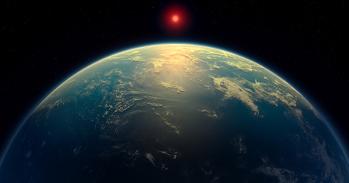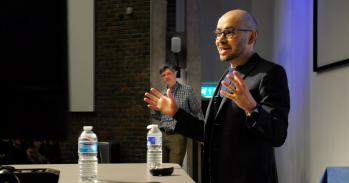Queloz jointly wins the 2019 Physics Nobel for his work on the first confirmation of an exoplanet – a planet that orbits a star other than our Sun.
Queloz jointly wins the 2019 Physics Nobel for his work on the first confirmation of an exoplanet – a planet that orbits a star other than our Sun.
Back then, exoplanet research was a very small field. I think there were about fifty of us and we were seen as weirdos
Didier Queloz on the early days of his research
Professor Didier Queloz from the University of Cambridge has been jointly awarded the 2019 Nobel Prize in Physics along with Professor James Peebles and Professor Michel Mayor for their pioneering advances in physical cosmology, and the discovery of an exoplanet orbiting a solar-type star.
Queloz is Professor of Physics at the University’s Cavendish Laboratory, and Fellow of Trinity College, Cambridge. He leads the Cambridge Exoplanet Research Centre. In 1995, along with Michel Mayor, Queloz made the first discovery of a planet outside our solar system, an exoplanet, orbiting the star 51 Pegasi. Queloz becomes the 109th affiliate of the University of Cambridge to be awarded a Nobel Prize.
The Royal Swedish Academy of Sciences announced the 2019 Prize this morning. The Nobel Assembly said: “The discovery by 2019 Nobel Prize laureates Michel Mayor and Didier Queloz started a revolution in astronomy and over 4,000 exoplanets have since been found in the Milky Way. Strange new worlds are still being discovered, with an incredible wealth of sizes, forms and orbits.”
"This year’s Laureates have transformed our ideas about the cosmos. While James Peebles’ theoretical discoveries contributed to our understanding of how the universe evolved after the Big Bang, Michel Mayor and Didier Queloz explored our cosmic neighbourhoods on the hunt for unknown planets. Their discoveries have forever changed our conceptions of the world."
Above: Listen to audio from the press conference given by Prof Queloz on the day the Nobel Prize was awarded.
"It’s an incredible honour and I’m still trying to digest it," said Queloz on the day he was awarded the Nobel. "When we discovered the first exoplanet, it was pretty obvious that this was something important, even though not everyone believed us at the time. Back then, exoplanet research was a very small field. I think there were about fifty of us and we were seen as weirdos. Now there are probably over a thousand people working in the field.
"It’s a hot topic at the moment, so I’m really happy that the field of exoplanets has been recognised with a Nobel Prize," Queloz said. "When you are working so passionately at your research, it can be very disruptive to your family. My family has always been there for me and I’m grateful of their support. This Nobel Prize is also an acknowledgement of their incredible patience!"
Today, many regard the discovery of 51 Pegasi b by Queloz and Mayor at the University of Geneva in 1995, as a moment in astronomy that forever changed the way we understand the universe and our place within it.
It was the first confirmation of an exoplanet – a planet that orbits a star other than our Sun. Until then, although astronomers had speculated as to the existence of these distant worlds, no planet other than those in our own solar system had ever been found.
This seminal discovery has spawned a revolution in astronomy both in terms of new instrumentation and understanding of planet formation and evolution. Since then Professor Queloz has been involved in a successful series of developments of precise spectrographs, considerable improving the precision of the Doppler technique.
Of the 1,900 or so confirmed exoplanets that have now been found – around a tenth of these by Queloz himself – many are different to anything we ever imagined, challenging existing theories of planet formation.
In 2007, in the emerging area of planetary transit detection, he established a successful international collaboration with the WASP team from UK, providing the spectroscopic confirmation and precise photometry follow-up to confirm and characterize planetary candidates. He also took an active part in the Corot mission, pioneering planet transit detection from space. He conducted a part of the work that led to the first transit detection of a rocky planet (Corot-7b).
In 2012 he received with Michel Mayor the 2011 BBVA Foundation Frontiers of Knowledge Award of Basic Sciences for developing new astronomical instruments and experimental techniques that led to the first observation of planets outside the Solar System.
In 2013 he became a professor at the University of Cambridge, where he is leading a comprehensive research program with the goal of progressing our understanding of the formation, structure, and habitability of exoplanets, as well as to promote and share the excitement of this work with the public.
The University's Vice-Chancellor, Professor Stephen Toope, said: "I am delighted to hear that Professor Didier Queloz has been awarded this year’s Nobel Prize in Physics. Didier’s discovery of planets beyond our solar system has ushered in a revolutionary new era for cosmology.
"This work represents an extraordinary scientific achievement but also offers humanity so much inspiration – the chance to imagine such distant and different, or perhaps similar, worlds. It gives me tremendous pleasure, on behalf of our community, to congratulate the University of Cambridge’s latest Nobel Prize winner.”
Professor Andy Parker, Head of the Cavendish Laboratory, said: "Professor Queloz’s research has led to the discovery that planets are abundant throughout our galaxy, orbiting other stars. We can now estimate that there are tens of billions of potentially inhabitable exoplanets. This takes us one step closer to answering the question of whether we are alone in the Universe: it seems increasingly likely that life in some form will have found a foothold on these many new worlds.
"The current programme of work being carried out by Professor Queloz at the Cavendish Laboratory at Cambridge University will search for signatures of life in the chemicals found in the exoplanet atmospheres. This groundbreaking research is extremely demanding technically, and addresses profound questions which fascinate all of humanity. We look forward to further breakthroughs as Professor Queloz continues his outstanding work."
Read a 2016 interview with Professor Queloz here.
My PI here in Cambridge, @DidierQueloz, just won the Physics Nobel Prize! We had to interrupt our SPECULOOS meeting to take an historical picture! Congrats Didier!!! pic.twitter.com/eGnsNAogcf
— Laetitia Delrez (@LaetitiaDelrez) October 8, 2019
New Nobel Laureate Didier Queloz was at a scientific meeting when news of his #NobelPrize broke. Here, fresh from celebrating with colleagues, he speaks with @nobelprize.
— The Nobel Prize (@NobelPrize) October 8, 2019
Interview to follow.
Photo: Nick Saffell. pic.twitter.com/7FyURzjzAq
A perspective from Lord Martin Rees, Astronomer Royal and Emeritus Professor of Cosmology and Astrophysics at the University of Cambridge:
"Jim Peebles played a key role back in 1965 in appreciating and interpreting the ‘cosmic microwave background’ radiation – the ‘afterglow of creation’. He has been the most influential and respected leader of empirical cosmology with a sustained record of achievement spanning half a century.
"The study of exoplanets is perhaps the most vibrant field of astronomy. We now know that most stars are orbited by retinues of planets; there may be a billion planets in our galaxy resembling the Earth (similar in size and at a distance from their parent star where liquid water can exist). This takes us a step towards the fascinating question of detecting evidence for life on the nearest of these exoplanets. Queloz and Mayor not only discovered the first planet orbiting an ordinary star. The have also been among the leaders in the ongoing research that has led to the discovery of many thousands of other planetary systems, exhibiting an unexpected variety.
"These awards seem to show, incidentally, a welcome broadening of the Nobel criteria. In the past, astronomy has been included primarily when the discovery involves some new physics (neutron stars, gravitational waves, vacuum energy, etc). But this award highlights astronomy as also the grandest of the environmental sciences. And the award to Peebles will be welcomed by his friends and colleagues as recognition of a lifetime of sustained contributions and insights by an acknowledged intellectual leader, rather than a ‘one off’ achievement."

The text in this work is licensed under a Creative Commons Attribution 4.0 International License. Images, including our videos, are Copyright ©University of Cambridge and licensors/contributors as identified. All rights reserved. We make our image and video content available in a number of ways – as here, on our main website under its Terms and conditions, and on a range of channels including social media that permit your use and sharing of our content under their respective Terms.




